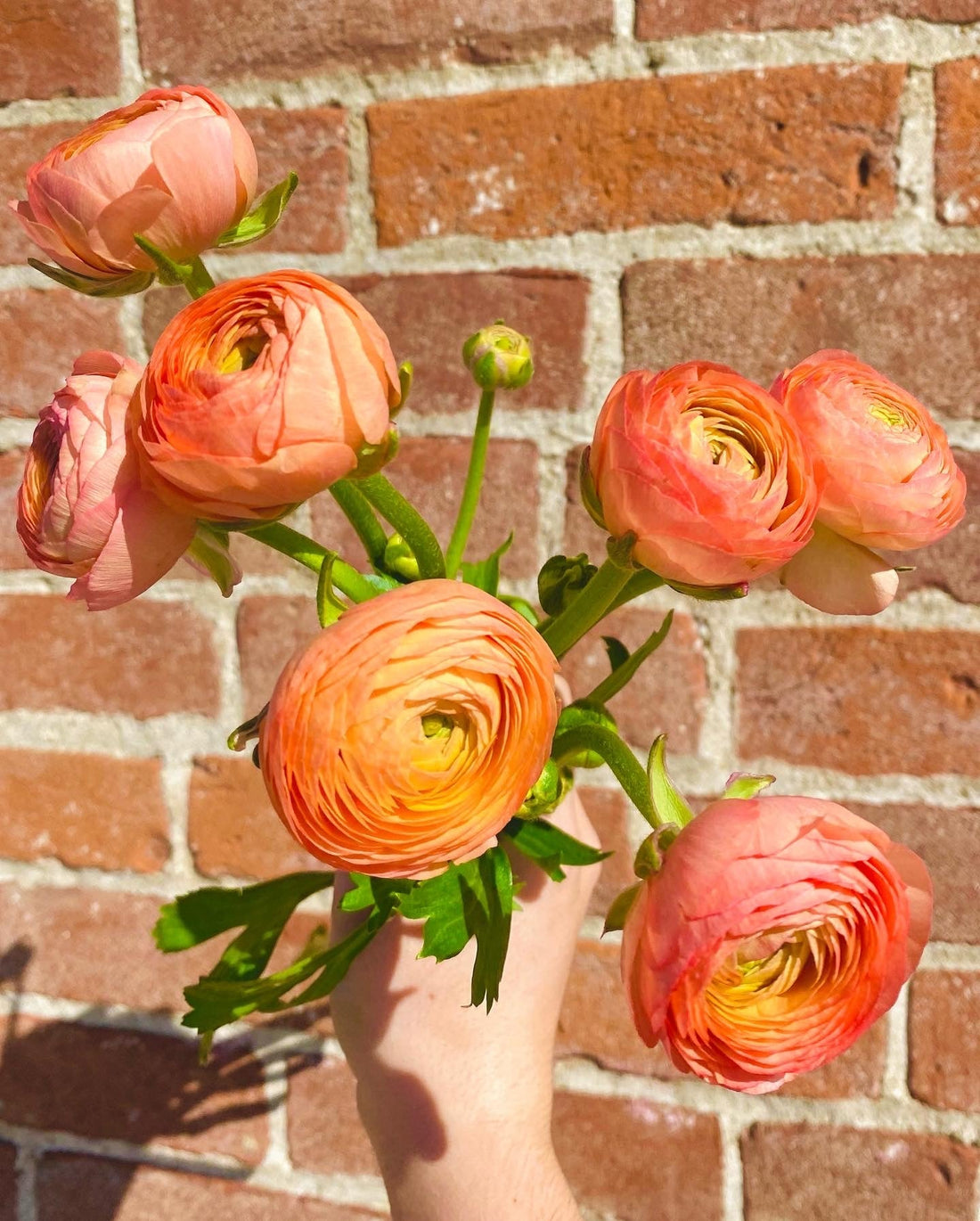
Spring Highlight:
Share
The Fascinating World of Ranunculus: A Bloom of Beauty and Symbolism
Introduction: The Beauty of Ranunculus
Flowers have always captivated our senses, whether through their fragrance, color, or intricate structure. Among the vast variety of blossoms that grace our gardens and homes, the ranunculus stands out as one of the most elegant and striking flowers. Known for its multi-layered, tissue-like petals and vibrant hues, the ranunculus is a popular choice in floral arrangements and a beloved symbol in various cultures.
In this blog, we will delve into the history, symbolism, growing tips, and uses of the ranunculus. From its origins in the wild to its modern-day cultivation in gardens and bouquets, ranunculus is much more than just a beautiful flower.
What is Ranunculus?
The ranunculus is a genus of plants that belongs to the buttercup family, Ranunculaceae. The name "Ranunculus" comes from the Latin word ranunculus, which means "little frog." This name likely stems from the flower’s preference for moist, wet habitats, which are often the home to frogs. Ranunculus flowers are native to a wide variety of regions, ranging from temperate zones in Europe and Asia to the Mediterranean and North America.
The most common species of ranunculus used in gardens and floral arrangements is Ranunculus asiaticus, known for its large, colorful blooms. These plants typically have a bulb-like structure and are often referred to as "Persian buttercups" due to their association with Persian gardens.
The Colorful Spectrum of Ranunculus
One of the standout features of ranunculus flowers is their stunning range of colors. From vibrant reds, pinks, and oranges to delicate pastels of yellow, peach, and lavender, these blooms can brighten up any space. The flowers also come in various bi-color and multi-color varieties, adding extra charm to their appearance.
Some of the most popular ranunculus colors and varieties include:
-
 Red Ranunculus: A symbol of love and passion, red ranunculus blooms are often used in romantic bouquets.
Red Ranunculus: A symbol of love and passion, red ranunculus blooms are often used in romantic bouquets. -
 Pink Ranunculus: These blooms represent admiration and gratitude, making them ideal for expressing appreciation.
Pink Ranunculus: These blooms represent admiration and gratitude, making them ideal for expressing appreciation. -
 White Ranunculus: White ranunculus flowers are often linked with purity and innocence and are a common choice for weddings.
White Ranunculus: White ranunculus flowers are often linked with purity and innocence and are a common choice for weddings. -
 Yellow Ranunculus: Yellow blooms convey joy, happiness, and friendship, often brightening up any bouquet or garden.
Yellow Ranunculus: Yellow blooms convey joy, happiness, and friendship, often brightening up any bouquet or garden. -
 Purple Ranunculus: These flowers symbolize charm, grace, and elegance, often seen in high-end floral designs.
Purple Ranunculus: These flowers symbolize charm, grace, and elegance, often seen in high-end floral designs. -
 Peach Ranunculus: Peach-colored ranunculus is associated with sincerity and admiration, frequently chosen for personal celebrations.
Peach Ranunculus: Peach-colored ranunculus is associated with sincerity and admiration, frequently chosen for personal celebrations.
Whether you're planting them in your garden or using them for decoration, the sheer variety of colors and shades makes ranunculus flowers perfect for a variety of occasions.
Ranunculus in History and Culture
The ranunculus has a rich history and a variety of symbolic meanings across cultures. In the language of flowers, or floriography, ranunculus is often associated with "radiance" and "charm." Its delicate appearance is also a symbol of fleeting beauty, a reminder of the impermanence of life and the importance of cherishing the present.
In ancient Roman and Greek cultures, the ranunculus was seen as a symbol of elegance and charm. The Greeks believed that the flower had the power to promote love and affection between lovers, making it a common offering in romantic gestures.
In Persian culture, ranunculus (or “gol-e-shirin” in Persian) was regarded as a symbol of beauty and grace. The flowers were highly prized in gardens and often used in art, appearing in intricate paintings and tapestries. In many parts of the Middle East, the ranunculus is still considered a symbol of love and the joy that comes from cultivating beautiful things.
In modern times, ranunculus is frequently used in wedding bouquets, signifying love, elegance, and good fortune for the newlyweds. The flower’s multi-layered petals and vibrant hues make it an ideal symbol of a blossoming, lasting love.
Ranunculus in Floral Arrangements
Due to its elegant appearance and rich variety of colors, ranunculus is a favorite among florists and is commonly used in various floral arrangements, including weddings, bouquets, and centerpieces. The flower's soft, layered petals give it a romantic and whimsical quality, making it a perfect addition to special occasions.
Wedding Bouquets
Ranunculus is a popular choice for wedding bouquets because of its versatility and beauty. Whether paired with other romantic flowers like roses, peonies, or tulips, or used on its own, ranunculus adds a touch of grace and charm. Its layered, intricate petals symbolize love, making it an ideal choice for couples looking to represent their bond on their big day.
Floral Design and Decoration
Ranunculus can be used in table arrangements, boutonnieres, and even wreaths. The flower’s full bloom can act as the focal point in a flower arrangement, drawing attention with its texture and color. Whether arranged with a mix of wildflowers or placed as a centerpiece in a modern design, ranunculus never fails to make an impression.
Conclusion: The Lasting Appeal of Ranunculus
Ranunculus is a flower that brings together beauty, symbolism, and versatility. Its radiant colors and captivating layers make it a standout in any garden, bouquet, or floral arrangement. Whether you're growing them yourself or admiring their beauty in a shop window, ranunculus flowers continue to charm people around the world. From ancient cultural associations with love and beauty to their modern-day popularity in weddings and decor, these flowers are truly timeless.
Whether you are a flower enthusiast or someone just looking to add a splash of color to your home, ranunculus will never disappoint. Its delicate nature and eye-catching colors make it a symbol of joy, elegance, and love — a fitting tribute to the fleeting yet exquisite moments that life offers.
